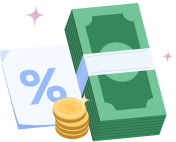Table of Contents
Signing a Loan Without Understanding the Terms? Here’s Why That’s Risky
Personal loans can be incredibly helpful if you know what you’re signing up for. The problem is, most people don’t. Across the United States, personal loan debt has climbed past 200 billion dollars, according to the official US Fiscal Data report. And a surprising number of borrowers jump in without fully reading or understanding the fine print on personal loan terms. That means missed fees, unexpected penalties, and more interest than they bargained for.
If you’re considering borrowing, don’t skip the homework. This guide breaks down the 10 most important personal loan terms you need to know before you apply. These aren’t just buzzwords. These are the real deal-breakers and game-changers that shape your borrowing experience.
And when you’re ready to compare actual offers, Beem’s Personal Loans Marketplace gives you access to loans up to 100,000 dollars with full transparency and no surprises.
People Also Read: Benefits of Taking a Personal Loan
Top 10 Personal Loan Terms You Must Know
1. APR (Annual Percentage Rate)
APR is more than just the interest rate. It reflects the true cost of borrowing by including any loan fees along with interest.
Two loans might both advertise a 9 percent interest rate, but one might include an origination fee or early repayment penalty, making the APR much higher. Always look at this number, not just the headline rate.
2. Principal
The principal is simply the amount you borrow before interest or fees kick in.
So if you take out a loan for 10,000 dollars, that’s your principal. Each monthly payment covers part of that amount plus the interest it’s earning.
3. Loan Term
The loan term is how long you’ll be repaying. It could be 12 months, 36 months, or even 84 months.
Longer terms lower your monthly payments, but you’ll likely pay more in total interest over time. Shorter terms are more aggressive but cheaper overall if you can afford the higher payments.
4. Origination Fee
This is a one-time fee that some lenders charge for processing your loan. It usually ranges between 1 and 8 percent of the loan amount.
For example, if you’re borrowing 10,000 dollars with a 5 percent origination fee, you’ll only receive 9,500 dollars but still pay interest on the full 10,000. That’s why a low interest rate doesn’t always mean a cheaper loan.
5. Prepayment Penalty
Yes, some lenders charge you for paying off your loan early.
It sounds backward, but it happens. If you think you might pay ahead of schedule, be sure to check the loan terms to avoid extra fees for doing the right thing.

6. Fixed vs. Variable Rates
A fixed rate stays the same throughout your loan. A variable rate can change over time.
Fixed rates offer predictable payments and better budgeting. Variable rates might look cheaper upfront but could increase later, especially if interest rates rise.
7. Debt-to-Income Ratio (DTI)
DTI is your monthly debt payments divided by your gross monthly income. It’s one of the key metrics lenders use to gauge your ability to repay.
If your DTI is over 36 percent, it could affect your chances of approval or raise your interest rate. Lower is always better here.
8. Cosigner
A cosigner is someone usually a family member or trusted friend with strong credit who agrees to take on the responsibility of your loan if you can’t repay it.
This can boost your approval odds or lower your rate, but it puts your cosigner at legal and financial risk. Make sure you both understand what’s at stake.
9. Secured vs. Unsecured Loans
Most personal loans are unsecured, meaning they’re based on your credit alone. A secured loan requires collateral like a car or savings account.
Unsecured loans are simpler and faster, but they often come with higher interest rates. Secured loans may offer lower rates but carry greater risk if you default.
10. Default
Default happens when you fail to make payments, usually for 90 days or more. Once in default, your credit score can take a serious hit, and the lender may pursue collections or legal action.
Avoiding default starts with choosing a loan that fits your budget from the beginning.
People Also Read: Personal Loan Requirements: Read This Before You Apply
What Makes Beem Personal Loans Marketplace Stand Out
Compare Offers Without Applying
With Beem, you can see loan options without a hard credit check. That means no impact on your credit score just for exploring what’s out there.
Loans from 500 to 100,000 dollars
Whether you’re consolidating debt, covering emergency expenses, or financing a major purchase, Beem shows you options that match your needs, big or small.
Find the Lowest Interest Rates Available
Beem pulls offers tailored to your profile, so you’re not just seeing what’s out there, you’re seeing what’s right for you. Click here to check your best-suited offer now!
Risks and Limitations of Personal Loans
Not All Lenders Are Transparent
Some lenders bury extra fees in the fine print of personal loan terms. Others push you to sign up for optional insurance or early payment penalties. Always read the full disclosure and trust platforms that value transparency with personal loan terms.
Debt Can Snowball
A personal loan might feel like a quick fix, but if you borrow without a clear repayment plan, you could fall deeper into debt. Make sure you’re borrowing for the right reasons and that your budget can handle the monthly payments.
Alternatives to Personal Loans
Beem Instant Cash – Everdraft™
If you just need a small amount like $10 to $1,000, Beem’s Everdraft™ is a great alternative. You get:
- Instant access
- No interest
- No due dates
- No credit check
- No income restrictions
Perfect for small gaps when life hits hard between paychecks.
Balance Transfer Credit Cards
These cards offer low or even zero percent APR for a set time, usually 12 to 18 months. They’re useful for paying off credit card debt, but they come with a risk. If you don’t clear the balance before the promo period ends, interest can jump dramatically.
Borrowing from Friends or Family
No interest and no credit check, but emotional debt is real. If you go this route, treat it like a formal agreement to avoid misunderstandings.
FAQs on Personal Loan Terms Demystified
What’s the most important loan term to compare?
APR. It reflects both interest and fees and shows the full cost of borrowing.
Is there any reason to choose a variable rate?
Only if you’re confident you can repay quickly or if you believe interest rates will stay low.
Will checking my personal loan rate through Beem hurt my credit?
No. Beem’s personal loan marketplace only uses soft credit pulls, which won’t impact your credit score.
Conclusion
Getting a personal loan without understanding the terms is like signing a contract blindfolded. Don’t risk it.
From APR to DTI to origination fees and prepayment penalties, knowing the vocabulary gives you the power to borrow smarter, not just faster.
Beem’s Personal Loans Marketplace helps you compare offers side by side, with no pressure and no surprises. And if you’re in a bind and just need a smaller amount quickly, Beem’s Instant Cash Everdraft™ is a stress-free solution without the trap of interest or fees.
Choose wisely. Borrow responsibly. And always read the fine print on all personal loan terms before you apply.

















































